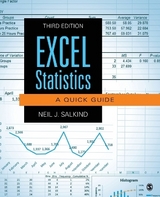
Excel Statistics
SAGE Publications Inc (Verlag)
978-1-4522-5792-1 (ISBN)
- Titel erscheint in neuer Auflage
- Artikel merken
Designed for users already familiar with basic computer operations, Neil J. Salkind's Excel Statistics: A Quick Guide shows readers how to utilize the features of Microsoft Excel to answer both simple and complex questions about data analysis. Excel novices and experts alike will find this text not only practical but easy to use and engaging. Key features: - Each function and tool is accompanied by an Excel file, accessible through the SAGE Web site, to be used as an example of each analysis. Access these files through the SAGE website or through www.onlinefilefolder.com. - The screenshots and steps feature Microsoft Excel 2010 and are compatible with Microsoft 97-2003 and Excel 5.0/95.
Neil J. Salkind received his PhD from the University of Maryland in Human Development. After teaching for 35 years at the University of Kansas, he remains a professor emeritus in the department of psychology and research in education, where he continues to collaborate with colleagues and work with students. His early interests were in the area of children's cognitive development, and after research in the areas of cognitive style and (what was then known as) hyperactivity, he was a postdoctoral fellow at the University of North Carolina's Bush Center for Child and Family Policy. His work then changed direction to focus on child and family policy, specifically the impact of alternative forms of public support on various child and family outcomes. He has delivered more than 150 professional papers and presentations, written more than 100 trade and textbooks, and is the author of Statistics for People Who (Think They) Hate Statistics (SAGE), Theories of Human Development (SAGE), and Exploring Research (Prentice Hall). He has edited several encyclopedias, including the Encyclopedia of Human Development, the Encyclopedia of Measurement and Statistics, and the recently published Encyclopedia of Research Design. He was editor of Child Development Abstracts and Bibliography for 13 years and lives in Lawrence, Kansas, where he likes to read, swim with the River City Sharks, letterpress print using 1820s technology, bake brownies (see the Excel version of Statistics for People Who (Think They) Hate Statistics for the recipe at http://www.statisticsforpeople.com), and poke around old Volvos and old houses.
Part I. Using Excel Functions 1. Computing Averages Excel QuickGuide 1. The AVERAGE Function Excel QuickGuide 2. The MEDIAN Function Excel QuickGuide 3. The MODE.SNGL Function Excel QuickGuide 4. The GEOMEAN Function 2. Looking at Variability Excel QuickGuide 5. The STDEV.S Function Excel QuickGuide 6. The STDEV.P Function Excel QuickGuide 7. The VAR.S Function Excel QuickGuide 8. The VAR.P Function 3. Describing Data Excel QuickGuide 9. The FREQUENCY Function Excel QuickGuide 10. The NORM.DIST Function Excel QuickGuide 11. The PERCENTILE.INC Function Excel QuickGuide 12. The PERCENTRANK.INC Function Excel QuickGuide 13. The QUARTILE.INC Function Excel QuickGuide 14. The RANK.AVG Function Excel QuickGuide 15. The STANDARDIZE Function 4. Looking at Relationships Excel QuickGuide 16. The COVARIANCE.S Function Excel QuickGuide 17. The CORREL Function Excel QuickGuide 18. The PEARSON Function Excel QuickGuide 19. The INTERCEPT Function Excel QuickGuide 20. The SLOPE Function Excel QuickGuide 21. The TREND Function Excel QuickGuide 22. The FORECAST Function Excel QuickGuide 23. The RSQ Function 5. Tests of Independence Excel QuickGuide 24. The CHISQ.DIST Function Excel QuickGuide 25. The CHISQ.TEST Function 6. Tests of Significance Excel QuickGuide 26.The F.DIST Function Excel QuickGuide 27. The F.TEST Function Excel QuickGuide 28. The T.DIST Function Excel QuickGuide 29. The T.TEST Function Excel QuickGuide 30. The Z.TEST Function 7. Looking at Data Excel QuickGuide 31. The AVERAGEIF Function Excel QuickGuide 32. The COUNT Function Excel QuickGuide 33. The COUNTA Function Excel QuickGuide 34. The COUNTBLANK Function Excel QuickGuide 35. The COUNTIF Function Part II. Using the Analysis Toolpak 8. Describing Data Excel QuickGuide 36. Descriptive Statistics Excel QuickGuide 37. Moving Average Excel QuickGuide 38. Random Number Generation Excel QuickGuide 39. Rank and Percentile Excel QuickGuide 40. Sampling 9. Comparing Means Excel QuickGuide 41. z-Test: Two-Sample for Means Excel QuickGuide 42. t-Test: Paired Two-Sample for Means Excel QuickGuide 43. t-Test: Two-Sample Assuming Unequal Variances Excel QuickGuide 44. t-Test: Two-Sample Assuming Equal Variances Excel QuickGuide 45. Anova: Single Factor Excel QuickGuide 46. Anova: Two-Factor with Replication Excel QuickGuide 47. Anova: Two-Factor without Replication 10. Looking at Relationships Excel QuickGuide 48. The Correlation Tool Excel QuickGuide 49. The Regression Tool 11. Illustrating Data Excel QuickGuide 50. The Histogram Tool Appendix A. Answers to QuickGuide Questions Appendix B. The Formula Builder (for Mac users)
| Erscheint lt. Verlag | 16.1.2013 |
|---|---|
| Zusatzinfo | Illustrations |
| Verlagsort | Thousand Oaks |
| Sprache | englisch |
| Maße | 187 x 232 mm |
| Themenwelt | Mathematik / Informatik ► Informatik ► Office Programme |
| Sozialwissenschaften ► Soziologie | |
| ISBN-10 | 1-4522-5792-2 / 1452257922 |
| ISBN-13 | 978-1-4522-5792-1 / 9781452257921 |
| Zustand | Neuware |
| Informationen gemäß Produktsicherheitsverordnung (GPSR) | |
| Haben Sie eine Frage zum Produkt? |
aus dem Bereich



